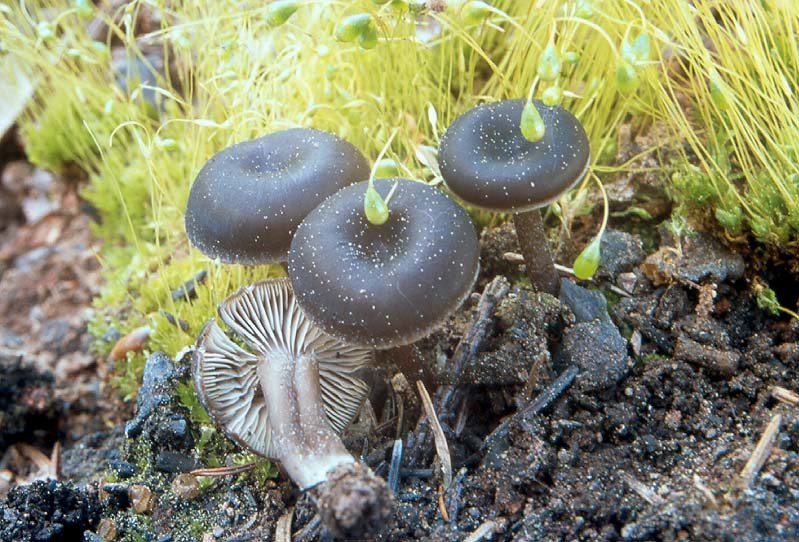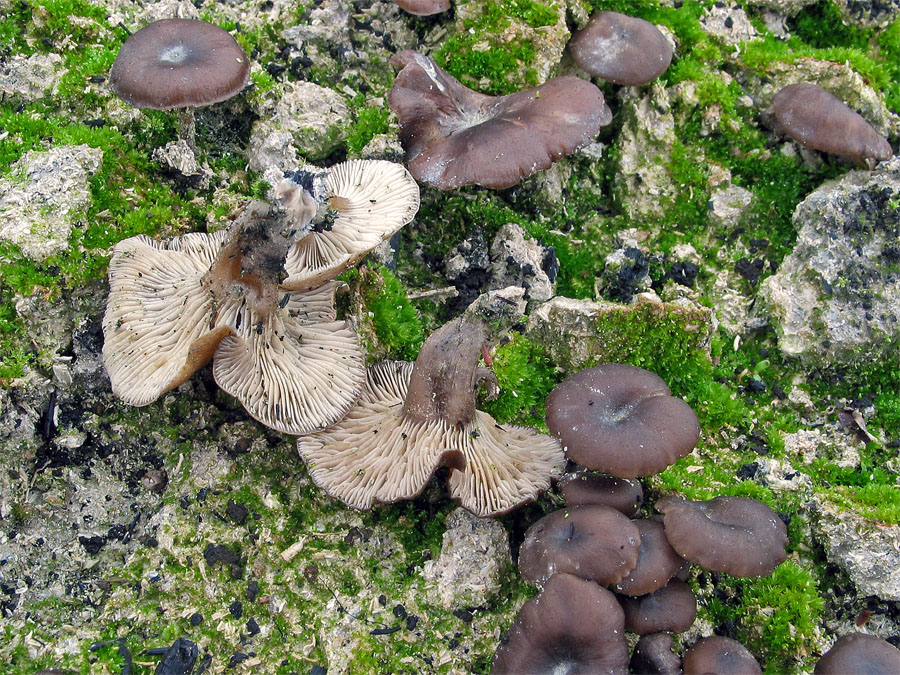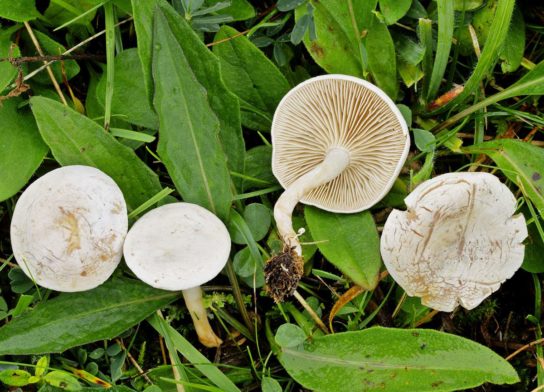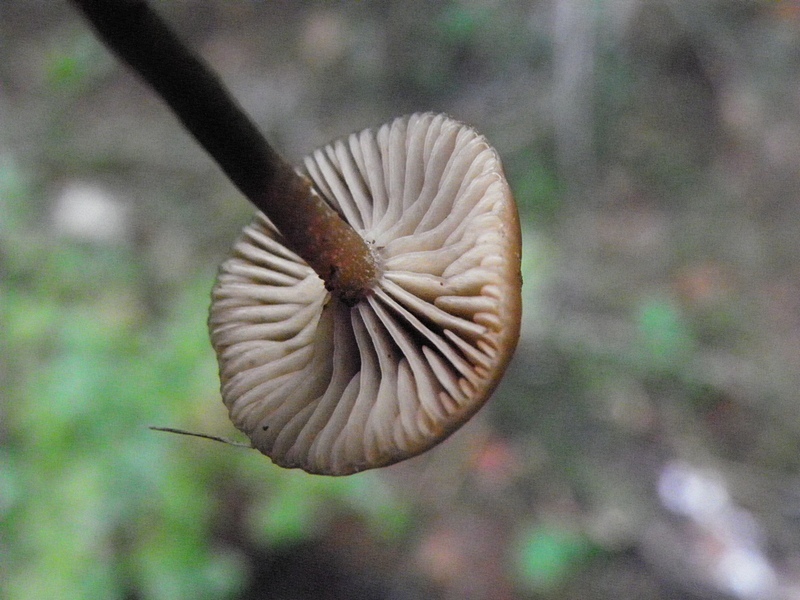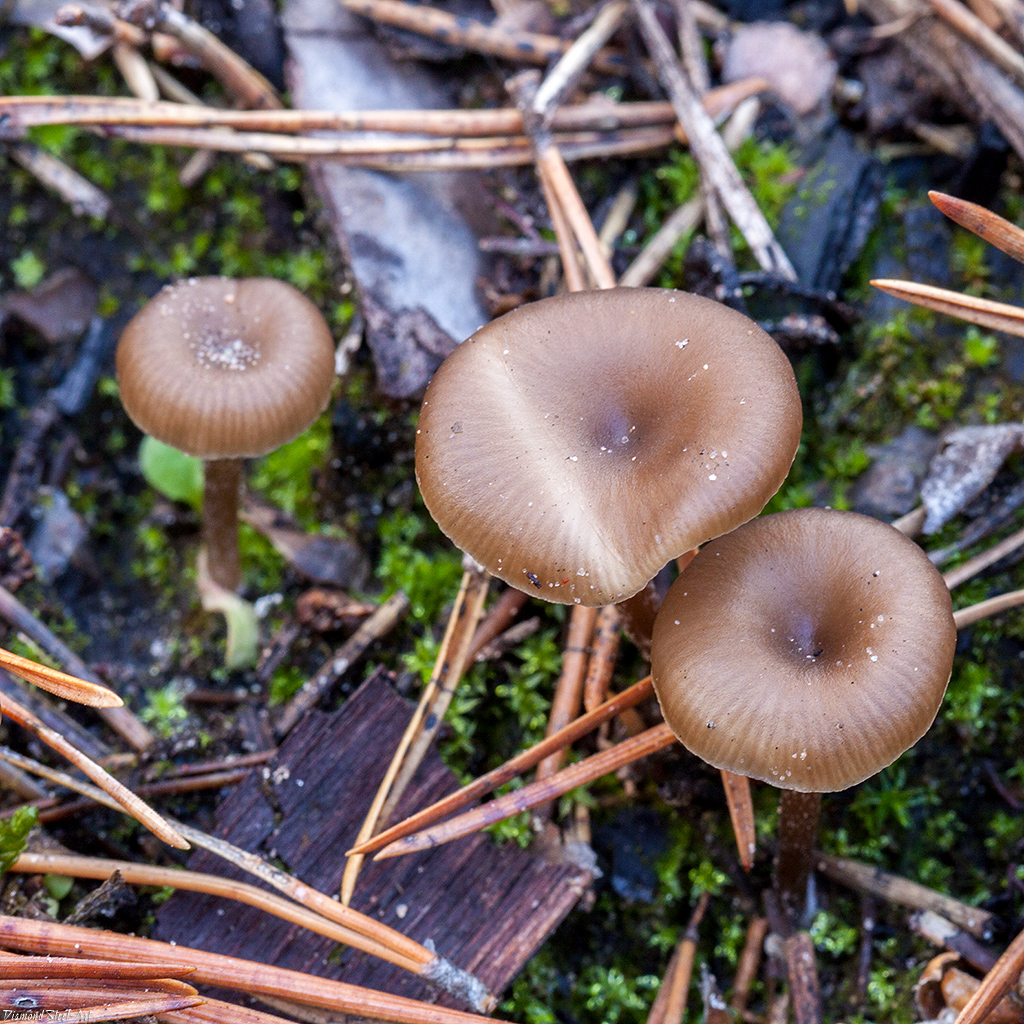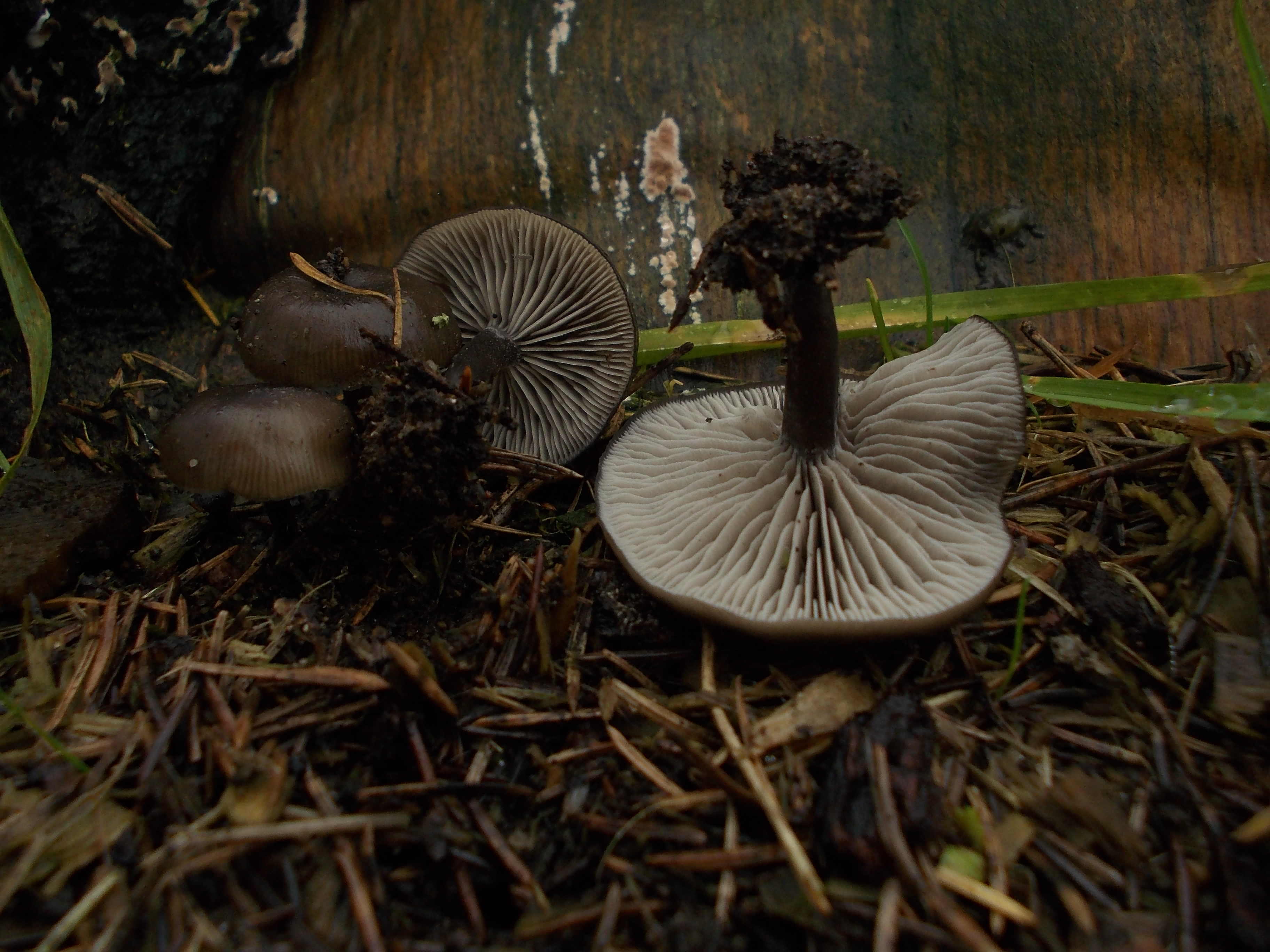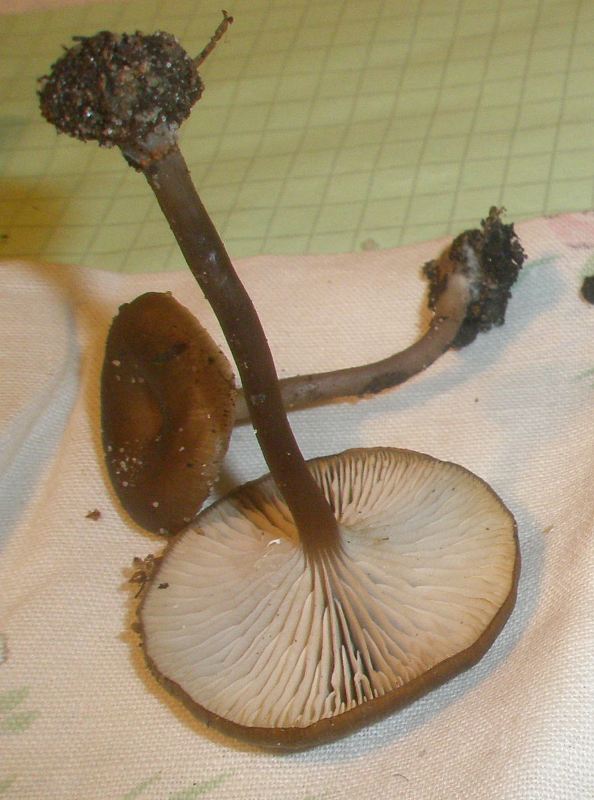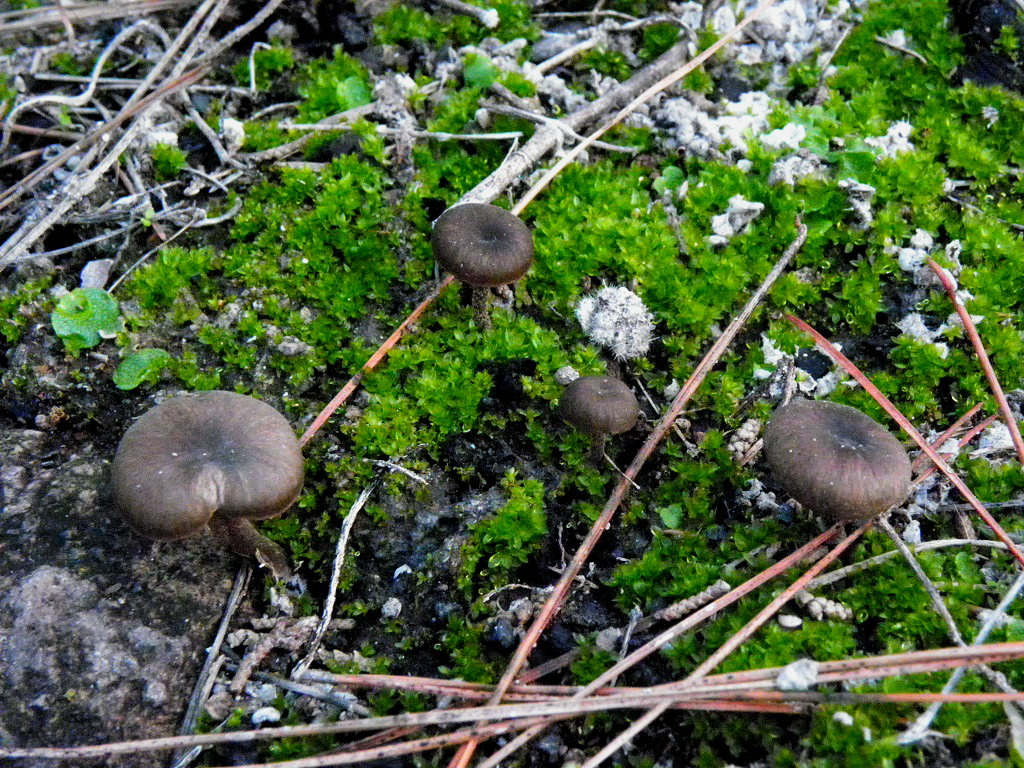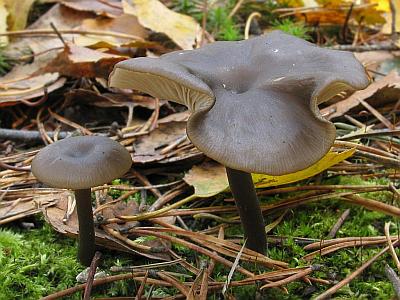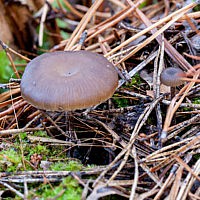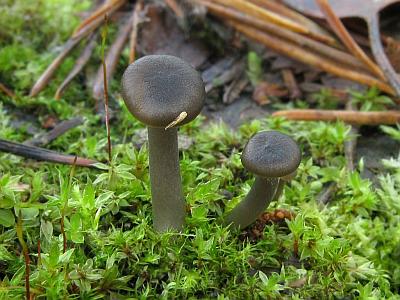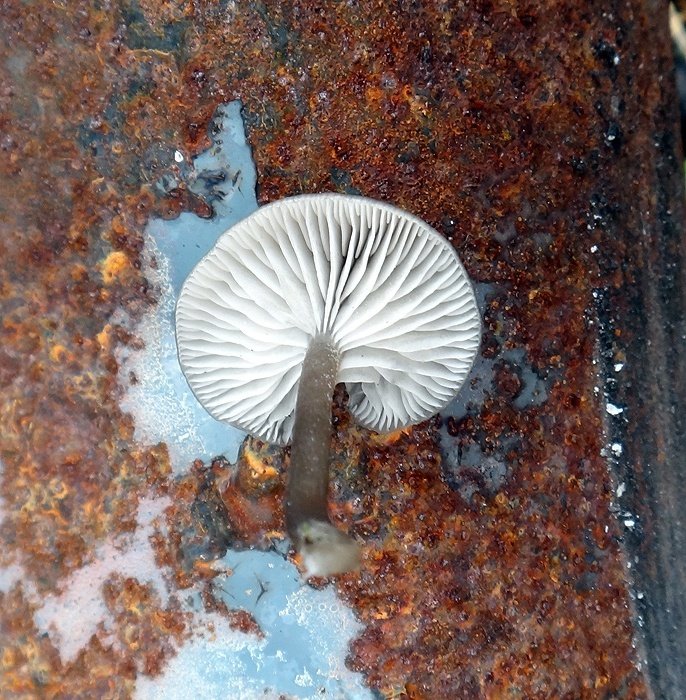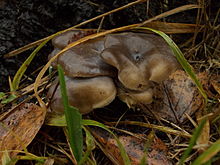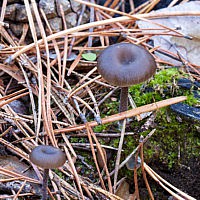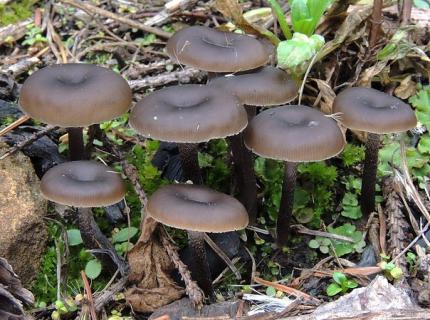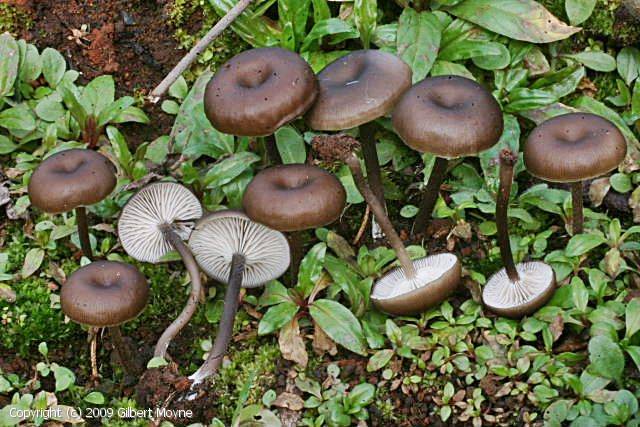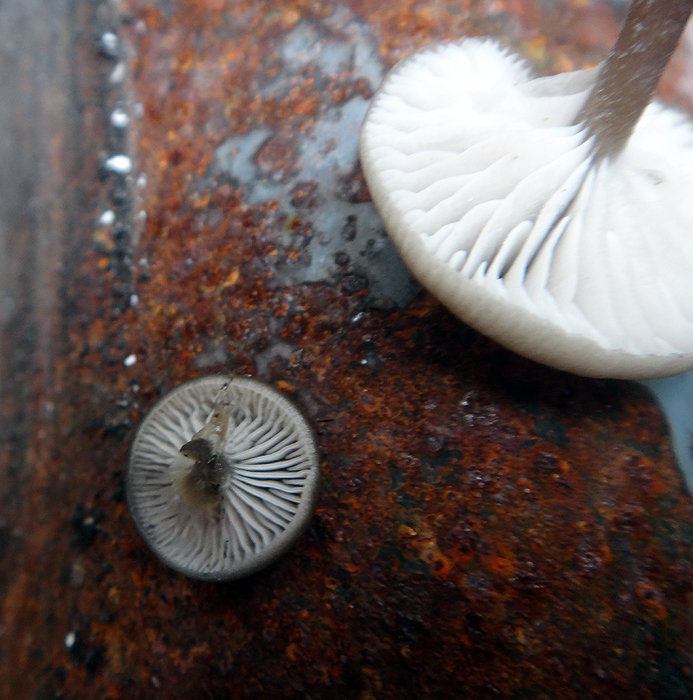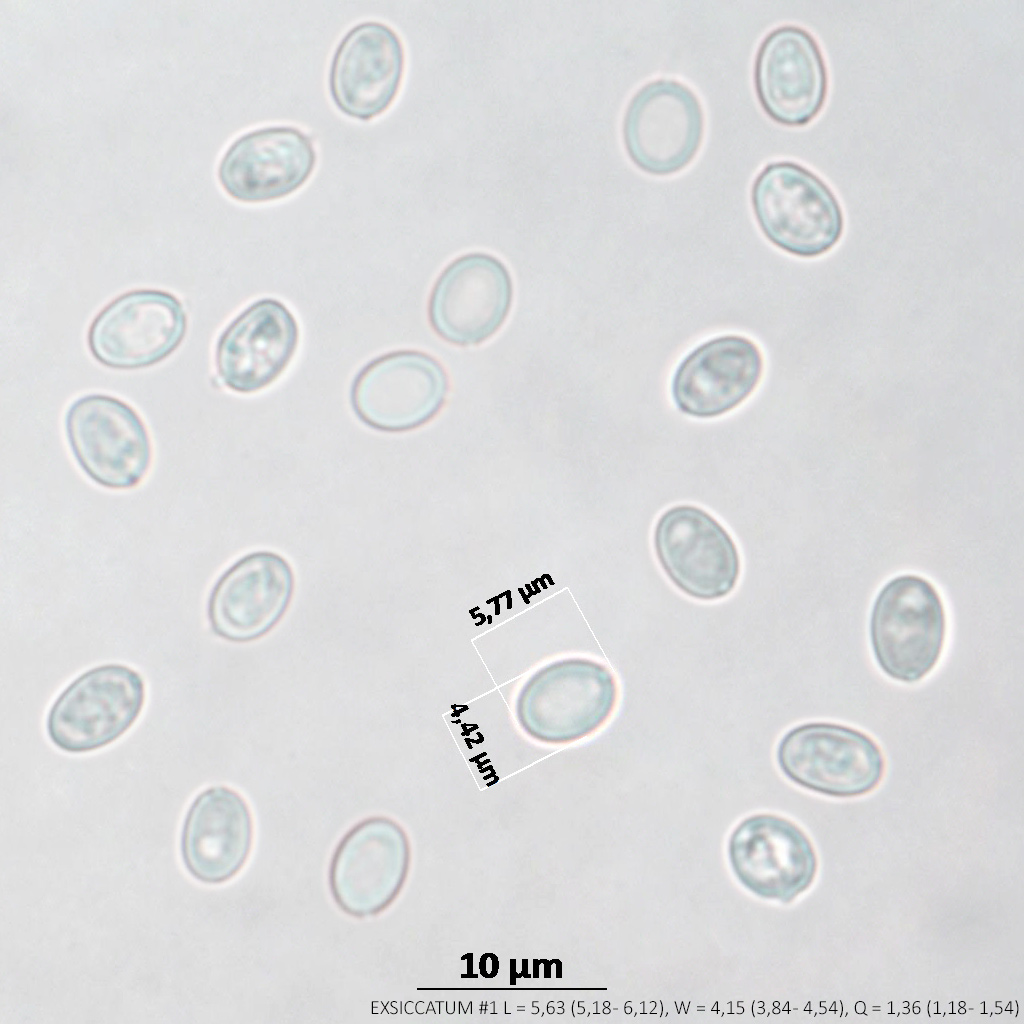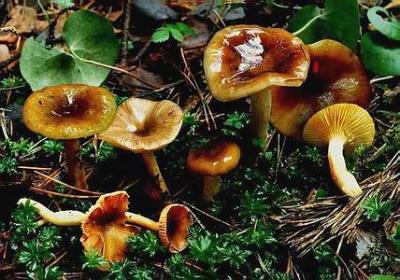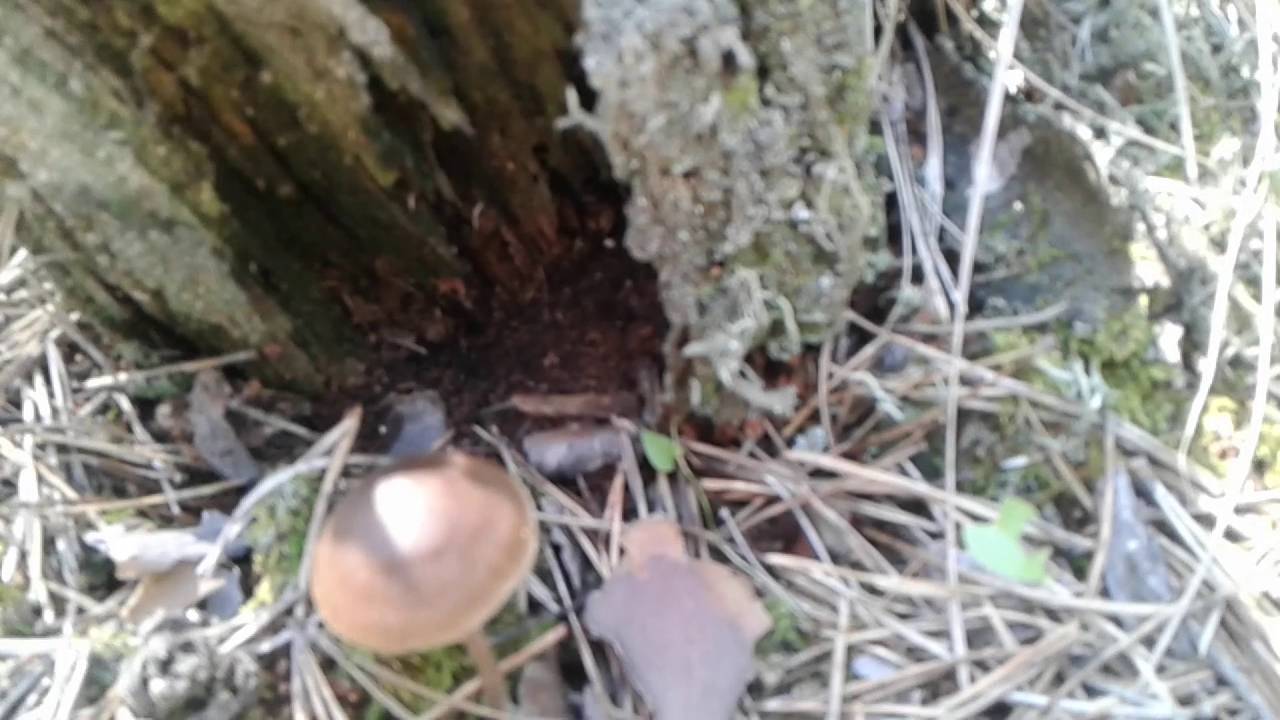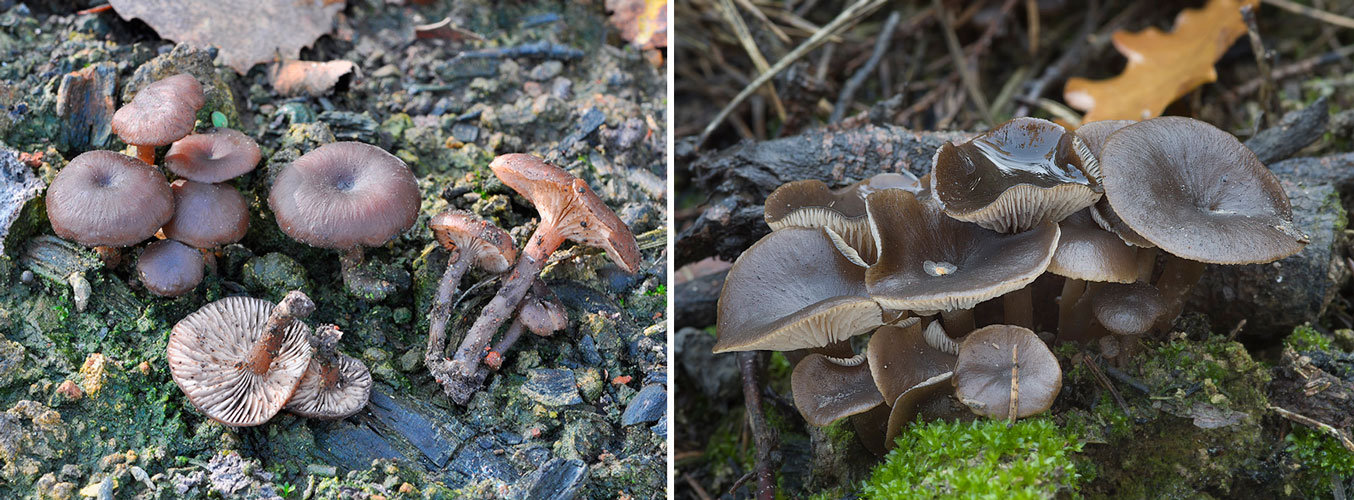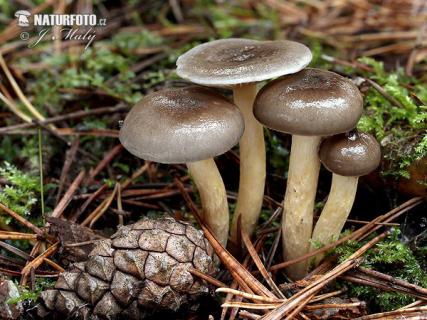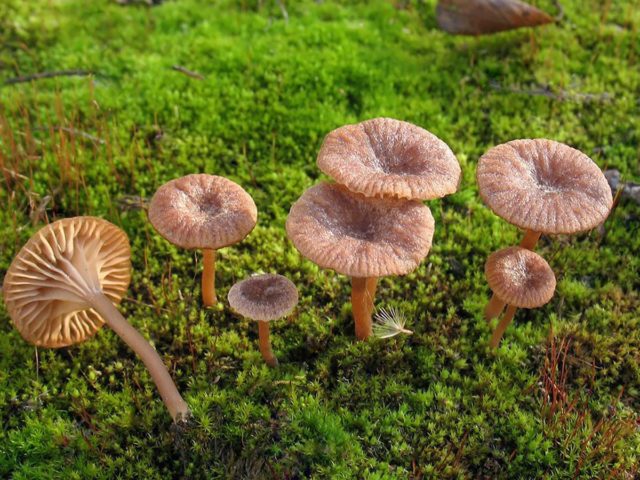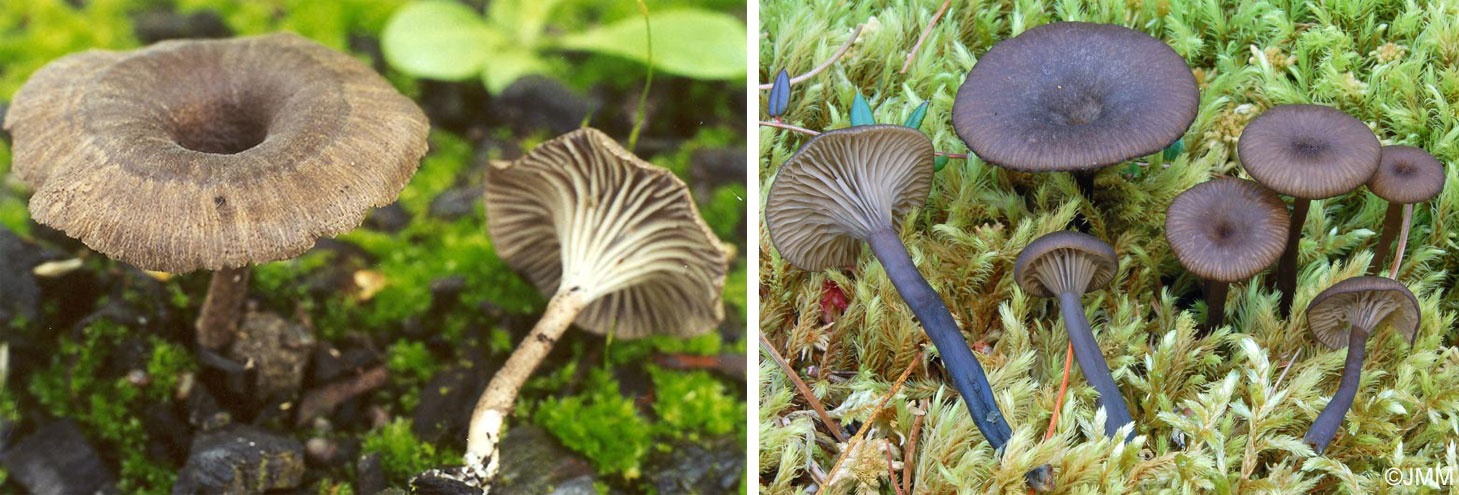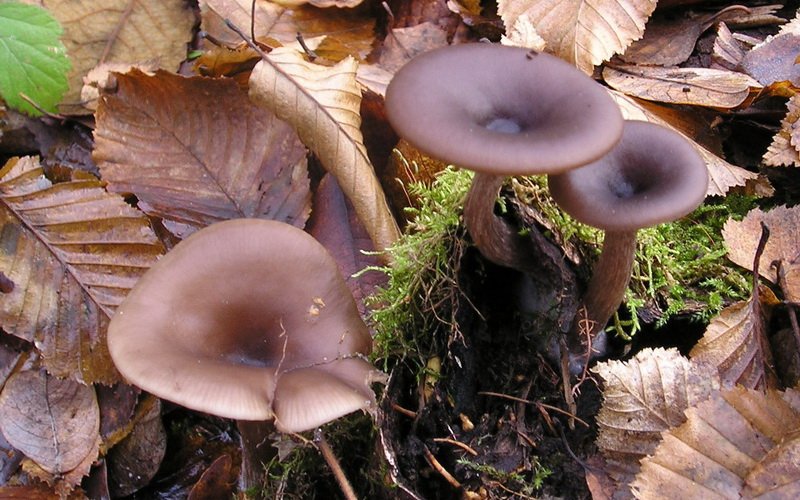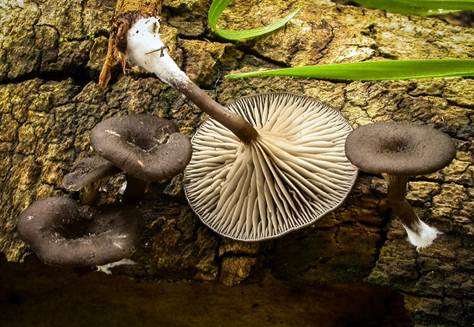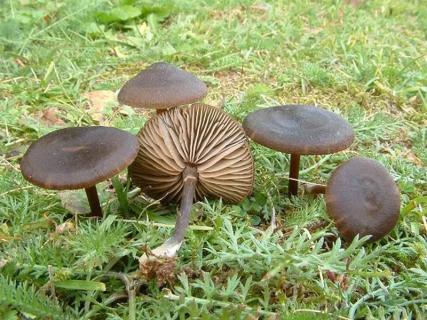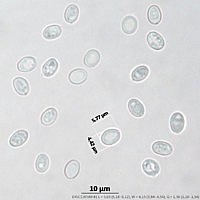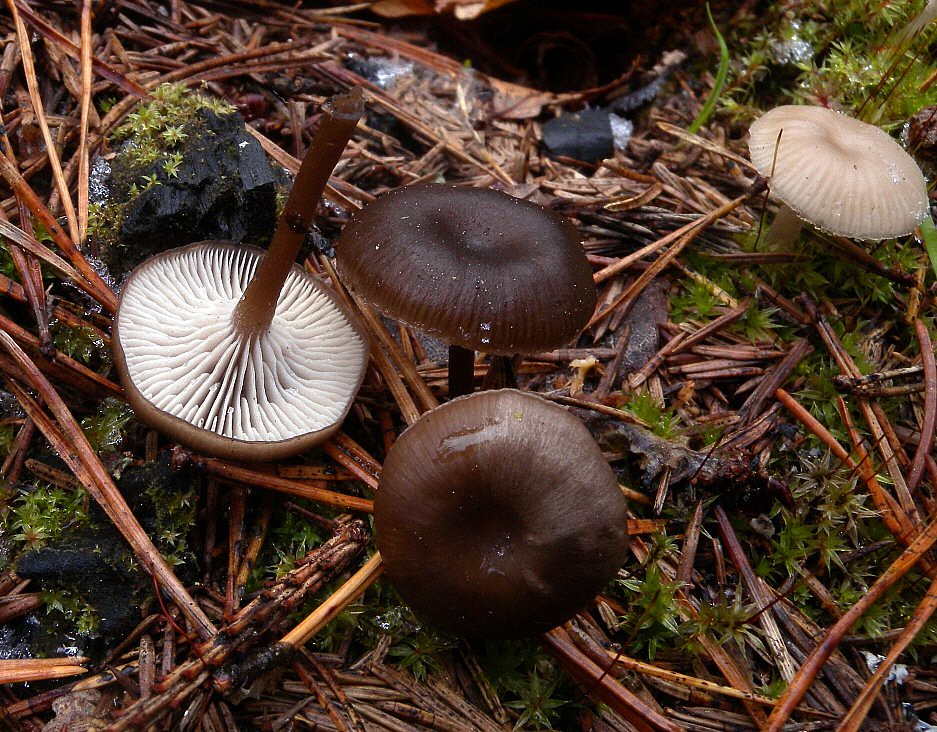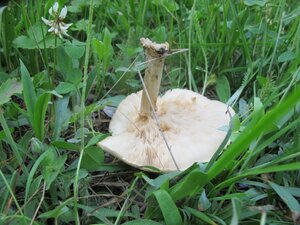Taxonomy [edit]
First time view Myxomphalia maura was described by the eminent Swedish mycologist Elias Fries in 1821 in the book Systema mycologicum... Fries placed it in a prefabricated genus of lamellar mushrooms. Agaricus... The neotype was collected in 1957 by H. Belin in the city forest (Stadsskogen) Uppsala.
For the first time title Myxomphalia was used by R. Kühner in 1938. Kühner singled out cinder mixomphaly into a separate section within a large genus Mycena, however, did not provide the highlighted taxon with the required Latin description. In 1959, Howard Bigelow raised the Kuhner taxon to the rank of a genus, but did not describe it either. A year later, in 1960, Bayard Hora did indeed describe the monotypic genus Myxomphalia.
The genus is included in the family Ryadovkovy (Tricholomataceae). Until the end of the 20th century, it usually did not stand out from the genus Fayodia. The closest morphologically genera are Fayodia in its modern sense and Gamundia. Fayodia It differs in spherical spores with a two-layer wall, one of the layers of which is amyloid, and the second is non-amyloid, double-core basidia, the absence of pleurocystids on the plates and non-gelatinized hyphae. For Gamundia, Unlike Myxomphalia, thin-walled non-amyloid spores of an elliptical shape are characteristic.
In the genus, only one polymorphic species is often recognized - Myxomphalia maura, sometimes divided into 2-4 species.
Genus synonyms:
- Fayodia subg. Myxomphalia Singer, 1943, nom. inval.
- Mycena sect. Myxomphalia Kühner, 1938, nom. inval.
- Myxomphalia H.E. Bigelow, 1959, nom. inval.
Homotypic synonyms of Myxomphalia maura (Fr.) Hora, 1960:
- Agaricus maurus Fr., 1821basionym
- Fayodia maura (Fr.) Singer, 1936
- Gymnopus maurus (Fr.) Murrill, 1916
- Hemimycena maura (Fr.) Singer, 1938
- Mycena maura (Fr.) Kühner, 1935, nom. illeg.
- Omphalia maura (Fr.) Gillet, 1876
- Omphalina maura (Fr.) Quél., 1886
Other taxa assigned to the genus Myxomphalia:
- Fayodia agloea Singer & Passauer, 1980 - described from a single specimen discovered in May 1976 by O. Mogh in a dark cave in the Austrian commune of Aurach am Hongar. Outwardly similar to Myxomphalia maura, differs in slightly gelatinized or not at all gelatinized hyphae, fusiform cystids and slightly smaller spores. Later finds of this species have not been reported.
- Agaricus invitus P. Karst., 1876 - described on the model of P. Karsten from Tammela (southern Finland). The type sample turned out to be morphologically identical Myxomphalia maura.
- Fayodia marthae Singer & Clémençon, 1971 - described based on samples found by R. Singer in 1971 in Valle d'Aosta (northern Italy). As directed by Singer and Clemenson, differs from Myxomphalia maura a very dark cap, wide plates and a short stem, which is included in the variability of the type species. Microscopically different from typical Myxomphalia maura inlaid hyphae under the cuticle of the cap, which is also not a sufficient feature to distinguish the species.
- Mycena maura f. alba Kühner, 1938, nom. inval. - differs from typical Myxomphalia maura pure white fruiting bodies. Samples are lost. The existence of a white form, growing interspersed with the usual, was confirmed by Hora, the author of the genus. In 1975, white myxomphalia were collected in Morocco by J. Malenson and R. Berto, the status of this taxon is currently unclear, the name is invalid.
Omphalina cinder (myxomphaly cinder): photo and description
| Name: | Omphalina cinder |
| Latin name: | Omphalina maura |
| Type of: | Inedible |
| Synonyms: | Fayodia charcoal, Fayodia maura), Myxomphalia cinder, Myxomphalia maura), Omphalia maura |
Omphalina cinder-representative of the Tricholomykh family. The Latin name is omphalina maura. This species has several synonyms: coal fayodia and cinder mixomphaly. All these names in one way or another indicate the unusual place of growth of this specimen.
Description of omphaline cinder

This species prefers mineral-rich, moist soil or burnt areas
The fruit body of the cinder omphaline is rather peculiar - due to its dark color. The pulp is thin, has a light powdery aroma, the taste is not pronounced.
Description of the hat
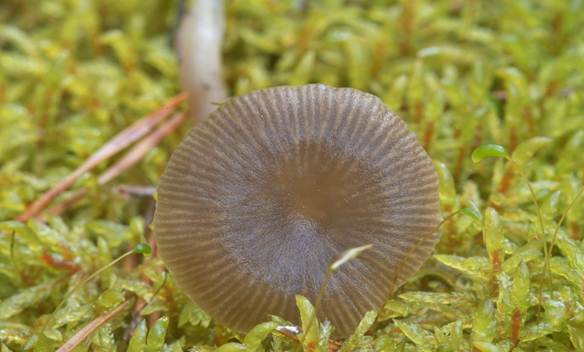
Grows singly or in groups in open areas
At the initial stage of development, the cap is convex in shape with tucked edges inward and a slightly squeezed center. Mature specimens are distinguished by a funnel-shaped, deeply depressed cap with uneven and wavy edges. Its size reaches a diameter of about 5 cm. The surface of the omphaline cinder cap is hygrophane, radially striped, smooth and dry, becomes sticky during the rainy season, and in drying specimens - shiny, grayish tone.
The peel from the cap of the cinder omphaline is removed quite easily. The cap is thin fleshy, its color varies from olive brown to dark brown shades.Under the cap there are frequent plates running down to the leg. Painted in white or beige shades, less often in yellowish. The spores are elliptical, smooth and transparent.
Leg description

Omphalina grows throughout the summer and in the first half of autumn.
The leg of the omphaline cinder is cylindrical, hollow, reaches no more than 4 cm in length, and up to 2.5 mm in diameter. As a rule, its color coincides with the color of the cap, but at the base it can be darker by several tones. The surface is longitudinally ribbed or smooth.
Where and how it grows
A favorable time for Omphalina cinder is the period from June to September. It prefers to grow in coniferous forests, and is also quite common in open areas, for example, in gardens or meadows, as well as in the middle of old fireplaces. Carries out fruiting one by one or in small groups. Quite widespread in Russia, as well as in Western Europe and North Africa.
Is the mushroom edible or not
This species belongs to the category of inedible mushrooms. Despite the fact that omphaline cinder contains no toxic substances, it is not suitable for food.
Doubles and their differences
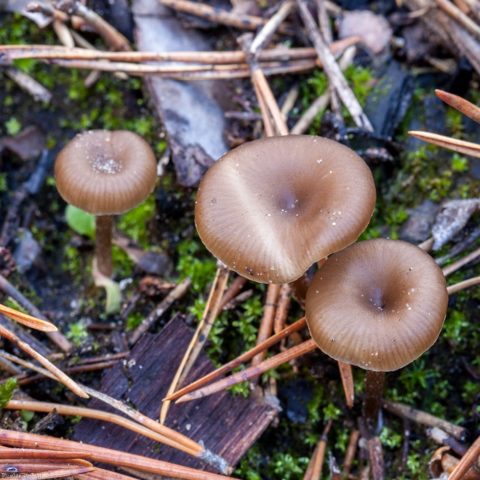
This species has no poisonous counterparts.
Omphalina cinder in appearance is similar to some gifts of the forest:
- Omphalina goblet - belongs to the group of inedible mushrooms. The twin's cap is funnel-shaped with a depressed central part, painted in light brown or dark brown shades. The surface is striped, smooth to the touch. The stem is thin, grayish-brown in color, the length of which is about 2 cm, and the thickness is no more than 3 mm in diameter. As a rule, it grows on deciduous and coniferous trees, which is the main difference from cinder omphaline.
- Omphalina Hudson is an inedible gift of the forest. Initially, the cap is convex in shape with edges tucked inward, as it grows, it becomes funnel-shaped, about 5 cm in diameter.It is painted in brown shades, fades in dry weather and acquires lighter colors. It does not have a pronounced smell and taste. Stem is hollow, almost even, slightly pubescent at the base. A distinctive feature of the cinder omphaline is the location of the mushrooms. So, the twin prefers to be located singly or in small groups among sphagnum or green mosses.
- Cinder scale - grows from May to October in coniferous forests on old fireplaces. At the initial stage, the cap is convex, after a while it is spread out with a small tubercle in the center. You can distinguish a double by the color of the fruiting body. So, the cap of cinder flakes is painted in yellow-ocher or reddish-brown shades. The leg is the same color as the cap, but at the base it may be a couple of tones darker. Light scales are located along its entire length, which form a zigzag pattern. Due to its hard pulp, it is not suitable for food.
Conclusion
Omphalina cinder is a rather interesting specimen, which differs from its relatives in the dark color of fruit chalk. But this gift of the forest does not carry any nutritional value, and therefore it is not recommended to collect. Despite the fact that no toxic substances were detected in the omphaline cinder, due to the thin pulp and small size of the fruit bodies, this specimen is not suitable for food.
Notes (edit)
- ↑ .
- ↑, p. 329-330.
- ↑ .
- .
- Fries, E.M. Systema mycologicum. - 1821. - Vol. 1. - P. 168. - 520 p.
- , p. 329.
- Kühner, R. (1938). "Le genre Mycena". Encyclopédie mycologique. 10: 535.
- Hora, F.B. (1960). “New check list of British agarics and boleti part IV. Validations, new species and critical notes ”. Transactions of the British Mycological Society. 43 (2): 453.
- , p. 325.
- Singer, R .; Passauer, U. (1979). "Höhlenbewohnende Agaricales". Sydowia. 32 (1—6): 299.
- , p. 326-327.
- Karsten, P.A. (1876). “Mycologia Fennica. Pars tertia. Basidiomycetes ". Bidrag till Kännedom av Finlands Natur och Folk. 25: 89.
- , p. 327-328.
- Singer, R .; Clémençon, H. (1971). “Neue Arten von Agaricales”. Schweizerische Zeitschrift für Pilzkunde. 49: 122.
- , p. 328-329.
- Hora, G.B. (1959). “Quantitative experiments on toadstool production in woods”. Transactions of the British Mycological Society. 42: 12.
- Malençon, G .; Bertault, R. (1975). “Flore des champignons superieurs du Maroc. Vol. II ”. Travaux de l'Institut scientifique chérifien et de la Faculté des sciences. 32.
- , p. 332.
Similar views [edit]
The characteristic fruiting bodies of myxomphaly, shiny due to gelatinized cuticle hyphae
Several other species have a similar color and grow on campfires and conflagrations; myxomphaly is usually easily distinguished from them by the mucous gelatinized cuticle of the cap and leg and the flour smell:
- Tephrocybe atrata (Fr.) Donk, 1962 - differs in non-gelatinized cuticle, dark plates and non-amyloid spores.
- Faerberia carbonaria (Alb. & Schwein.) Pouzar, 1981 - differs in non-gelatinized cuticle and strongly descending plates.
- Tephrocybe ambusta (Fr.) Donk, 1962 - differs in adherent plates, dry skin not separating from the cap, narrower and darker stem, non-amyloid spores.
Mullet

Mullet is a small (about 60 centimeters) commercial fish of the genus Mugilidae, which lives mainly in the sea and brackish waters of all tropical and warm seas; several species of mullet are found in the fresh waters of tropical America, Madagascar, Southeast Asia, Australia and New Zealand... In the United States, where the mullet is caught mainly off the coast of Florida, two varieties are most common: the striped mullet, which in Russia is called the striped mullet, and the white mullet.
Both of these are commonly fried or baked, and are often served for breakfast in the southern United States.
Mullet, a beautiful silvery fish with a small mouth, up to 40cm long with large scales. It swims in flocks, is very mobile, has the ability to jump out of the water when frightened, easily jumps over the exposed fixed nets. It becomes sexually mature at 6-8 years of life with a length of 30-40 cm. Spawns in May-September both in open and coastal waters.
In the cuisines of most countries of the world, you can find a variety of mullet dishes: it is stewed in a white wine sauce with onions and fish broth, breaded and fried in oil until crispy, baked with porcini mushrooms, or simply baked.
Calorie content of mullet
100 g of fresh mullet contains 124 kcal. It is quite nutritious due to its high protein content. 100 g of boiled mullet - 115 kcal. The calorie content of fried mullet is 187 kcal per 100 g of product. And 100 g of stewed mullet contains 79 kcal. The calorie content of cold smoked mullet is relatively low and is only 88 kcal. Moderate consumption of this type of fish will not harm the figure.
Nutritional value per 100 grams:
| Proteins, gr | Fat, gr | Carbohydrates, gr | Ash, gr | Water, gr | Calorie content, kcal |
| 17,5 | 2,3 | – | 0,3 | 70 | 124 |
Useful properties of mullet
Mullet has a very valuable, tender and tasty meat. Mullet contains fats, proteins, phosphorus, calcium, chlorine, zinc, chromium, fluorine, molybdenum, nickel, vitamins PP, B1, provitamin A.
Consuming fish helps prevent heart disease and stroke. This is because fish, as well as shellfish and crustaceans, contain a special type of oil called omega-3 that keeps the arteries healthy.
A heart attack or stroke is a consequence of blood clots blocking an artery. Why is omega-3 oil good for you? - It prevents the formation of these clots. Among other things, it helps to lower blood pressure, and this is exactly why people who eat a lot of fish are much less likely to have heart attacks and strokes.
Adults are advised to include fish in their diet at least twice a week. Any fish is good, but some fish are especially high in omega-3 oils, such as salmon, tuna, herring, trout, cod, mackerel, and mullet.
Dried and smoked products, canned food are prepared from mullet, and they are also sold chilled, frozen and salted. Fat in mullet contains from 4 to 9%, protein from 19 to 20%.
Oven-baked and boiled mullet is very useful for atherosclerosis, which means it is especially useful for elderly people.
Mullet is recommended for acute and chronic bowel diseases.
Dangerous properties of mullet
There are known cases of allergic reactions due to individual intolerance to fish.
The video will tell you about a quick and easy way of salting mullet.
Notes [edit]
- {{ |7}}
- ↑
- ↑, p. 329-330
- ↑
- Fries, E.M. Systema mycologicum. - 1821. - Vol. 1. - P. 168. - 520 p.
- , p. 329
- Kühner, R. (1938). "Le genre Mycena". Encyclopédie mycologique 10: 535.
- Hora, F.B. (1960). “New check list of British agarics and boleti part IV. Validations, new species and critical notes ". Transactions of the British Mycological Society 43 (2): 453.
- , p. 325
- Singer, R .; Passauer, U. (1979). Höhlenbewohnende Agaricales. Sydowia 32 (1—6): 299.
- , p. 326-327
- Karsten, P.A. (1876). "Mycologia Fennica. Pars tertia. Basidiomycetes ". Bidrag till Kännedom av Finlands Natur och Folk 25: 89.
- , p. 327-328
- Singer, R .; Clémençon, H. (1971). "Neue Arten von Agaricales". Schweizerische Zeitschrift für Pilzkunde 49: 122.
- , p. 328-329
- Hora, G.B. (1959). Quantitative experiments on toadstool production in woods. Transactions of the British Mycological Society 42: 12.
- Malençon, G .; Bertault, R. (1975).Flore des champignons superieurs du Maroc. Vol. II ". Travaux de l'Institut scientifique chérifien et de la Faculté des sciences 32.
- , p. 332
Notes [edit]
- {{ |7}}
- ↑
- ↑, p. 329-330
- ↑
- Fries, E.M. Systema mycologicum. - 1821. - Vol. 1. - P. 168. - 520 p.
- , p. 329
- Kühner, R. (1938). "Le genre Mycena". Encyclopédie mycologique 10: 535.
- Hora, F.B. (1960). “New check list of British agarics and boleti part IV. Validations, new species and critical notes ". Transactions of the British Mycological Society 43 (2): 453.
- , p. 325
- Singer, R .; Passauer, U. (1979). Höhlenbewohnende Agaricales. Sydowia 32 (1—6): 299.
- , p. 326-327
- Karsten, P.A. (1876). "Mycologia Fennica. Pars tertia. Basidiomycetes ". Bidrag till Kännedom av Finlands Natur och Folk 25: 89.
- , p. 327-328
- Singer, R .; Clémençon, H. (1971). "Neue Arten von Agaricales". Schweizerische Zeitschrift für Pilzkunde 49: 122.
- , p. 328-329
- Hora, G.B. (1959). Quantitative experiments on toadstool production in woods. Transactions of the British Mycological Society 42: 12.
- Malençon, G .; Bertault, R. (1975). Flore des champignons superieurs du Maroc. Vol. II ". Travaux de l'Institut scientifique chérifien et de la Faculté des sciences 32.
- , p. 332
Notes [edit]
- {{ |7}}
- ↑
- ↑, p. 329-330
- ↑
- Fries, E.M. Systema mycologicum. - 1821. - Vol. 1. - P. 168. - 520 p.
- , p. 329
- Kühner, R. (1938). "Le genre Mycena". Encyclopédie mycologique 10: 535.
- Hora, F.B. (1960). “New check list of British agarics and boleti part IV. Validations, new species and critical notes ". Transactions of the British Mycological Society 43 (2): 453.
- , p. 325
- Singer, R .; Passauer, U. (1979). Höhlenbewohnende Agaricales. Sydowia 32 (1—6): 299.
- , p. 326-327
- Karsten, P.A. (1876). "Mycologia Fennica. Pars tertia. Basidiomycetes ". Bidrag till Kännedom av Finlands Natur och Folk 25: 89.
- , p. 327-328
- Singer, R .; Clémençon, H. (1971). "Neue Arten von Agaricales". Schweizerische Zeitschrift für Pilzkunde 49: 122.
- , p. 328-329
- Hora, G.B. (1959). Quantitative experiments on toadstool production in woods. Transactions of the British Mycological Society 42: 12.
- Malençon, G .; Bertault, R. (1975). Flore des champignons superieurs du Maroc. Vol. II ". Travaux de l'Institut scientifique chérifien et de la Faculté des sciences 32.
- , p. 332
Notes (edit)
- ↑ .
- ↑, p. 329-330.
- ↑ .
- .
- Fries, E.M. Systema mycologicum. - 1821. - Vol. 1. - P. 168. - 520 p.
- , p. 329.
- Kühner, R. (1938). "Le genre Mycena". Encyclopédie mycologique 10: 535.
- Hora, F.B. (1960). “New check list of British agarics and boleti part IV. Validations, new species and critical notes ". Transactions of the British Mycological Society 43 (2): 453.
- , p. 325.
- Singer, R .; Passauer, U. (1979). Höhlenbewohnende Agaricales. Sydowia 32 (1—6): 299.
- , p. 326-327.
- Karsten, P.A. (1876). "Mycologia Fennica. Pars tertia. Basidiomycetes ". Bidrag till Kännedom av Finlands Natur och Folk 25: 89.
- , p. 327-328.
- Singer, R .; Clémençon, H. (1971). "Neue Arten von Agaricales". Schweizerische Zeitschrift für Pilzkunde 49: 122.
- , p. 328-329.
- Hora, G.B. (1959). Quantitative experiments on toadstool production in woods. Transactions of the British Mycological Society 42: 12.
- Malençon, G .; Bertault, R. (1975). Flore des champignons superieurs du Maroc. Vol. II ". Travaux de l'Institut scientifique chérifien et de la Faculté des sciences 32.
- , p. 332.
Notes (edit)
- ↑ .
- ↑, p. 329-330.
- ↑ .
- .
- Fries, E.M. Systema mycologicum. - 1821. - Vol. 1. - P. 168. - 520 p.
- , p. 329.
- Kühner, R. Le genre Mycena (unspecified) // Encyclopédie mycologique. - 1938 .-- T. 10. - S. 535.
- Hora, F.B. New check list of British agarics and boleti part IV. Validations, new species and critical notes // Transactions of the British Mycological Society: journal. - 1960. - Vol. 43, no. 2. - P. 453.
- , p. 325.
- Singer, R .; Passauer, U. Höhlenbewohnende Agaricales (English) // Sydowia (English) Russian .. - 1979. - Vol. 32, no. 1-6. - P. 299.
- , p. 326-327.
- Karsten, P.A. Mycologia Fennica. Pars tertia. Basidiomycetes (unspecified) // Bidrag till Kännedom av Finlands Natur och Folk. - 1876 .-- T. 25 .-- S. 89.
- , p. 327-328.
- Singer, R .; Clémençon, H. Neue Arten von Agaricales (unspecified) // Schweizerische Zeitschrift für Pilzkunde. - 1971. - T. 49. - S. 122.
- , p. 328-329.
- Hora, G.B. Quantitative experiments on toadstool production in woods // Transactions of the British Mycological Society: journal. - 1959. - Vol. 42 .-- P. 12.
- Malençon, G .; Bertault, R. Flore des champignons superieurs du Maroc. Vol. II (unspecified) // Travaux de l'Institut scientifique chérifien et de la Faculté des sciences. - 1975 .-- T. 32.
- , p. 332.
Notes (edit)
- ↑ .
- ↑, p. 329-330.
- ↑ .
- .
- Fries, E.M. Systema mycologicum. - 1821. - Vol. 1. - P. 168. - 520 p.
- , p. 329.
- Kühner, R. (1938). "Le genre Mycena". Encyclopédie mycologique. 10: 535.
- Hora, F.B. (1960). “New check list of British agarics and boleti part IV. Validations, new species and critical notes ”. Transactions of the British Mycological Society. 43 (2): 453.
- , p. 325.
- Singer, R .; Passauer, U. (1979). "Höhlenbewohnende Agaricales". Sydowia. 32 (1—6): 299.
- , p. 326-327.
- Karsten, P.A. (1876). “Mycologia Fennica. Pars tertia. Basidiomycetes ". Bidrag till Kännedom av Finlands Natur och Folk. 25: 89.
- , p. 327-328.
- Singer, R .; Clémençon, H. (1971). “Neue Arten von Agaricales”. Schweizerische Zeitschrift für Pilzkunde. 49: 122.
- , p. 328-329.
- Hora, G.B. (1959). “Quantitative experiments on toadstool production in woods”. Transactions of the British Mycological Society. 42: 12.
- Malençon, G .; Bertault, R. (1975). “Flore des champignons superieurs du Maroc. Vol. II ”. Travaux de l'Institut scientifique chérifien et de la Faculté des sciences. 32.
- , p. 332.
Notes [edit]
- {{ |7}}
- ↑
- ↑, p. 329-330
- ↑
- Fries, E.M. Systema mycologicum. - 1821. - Vol. 1. - P. 168. - 520 p.
- , p. 329
- Kühner, R. (1938). "Le genre Mycena". Encyclopédie mycologique 10: 535.
- Hora, F.B. (1960). “New check list of British agarics and boleti part IV. Validations, new species and critical notes ". Transactions of the British Mycological Society 43 (2): 453.
- , p. 325
- Singer, R .; Passauer, U. (1979). Höhlenbewohnende Agaricales. Sydowia 32 (1—6): 299.
- , p. 326-327
- Karsten, P.A. (1876). "Mycologia Fennica. Pars tertia. Basidiomycetes ". Bidrag till Kännedom av Finlands Natur och Folk 25: 89.
- , p. 327-328
- Singer, R .; Clémençon, H. (1971). "Neue Arten von Agaricales". Schweizerische Zeitschrift für Pilzkunde 49: 122.
- , p. 328-329
- Hora, G.B. (1959). Quantitative experiments on toadstool production in woods. Transactions of the British Mycological Society 42: 12.
- Malençon, G .; Bertault, R. (1975). Flore des champignons superieurs du Maroc. Vol. II ". Travaux de l'Institut scientifique chérifien et de la Faculté des sciences 32.
- , p. 332
Biological description
Mushroom cap. The cap reaches 1-4 cm in diameter, convex, with a tucked edge, in the center with a pronounced depression, hygrophane (well absorbing moisture), with plates translucent for more than half the diameter. The surface is smooth, with a well-removable mucous skin, colored in various shades of brown: from almost black and dark brown to yellow-brown, when dry it turns slightly pale to grayish-brownish. On fires, darker fruiting bodies are more common, while on mineral-rich soils, they are rather pale.
The hymenophore is lamellar, the plates are relatively frequent, descending to the pedicle, wide, with a slightly pubescent edge, painted in whitish or grayish tones, sometimes with a yellowish tinge.
The stem is central, 1.5-4 cm long and 0.15-0.5 cm thick, cylindrical, closer to the cap and slightly widened at the base, with cotton pulp, then hollow. The surface of the pedicle in the upper part with a small coating, sometimes with white pubescence at the base, along the entire length slightly lined longitudinally, painted in the same color with the cap or darker - dark brown or gray-brown.
The pulp is highly hygrometric, watery-brown in wet weather, whitish when dry, not brittle. The smell is floury or spermatic, often subtle. The taste is also floury or bland.
White spore print.
Spores 5-6.5 × 4-5 microns, broadly elliptic to elliptical, with a smooth thick amyloid and congophilic wall. Basidia are tetrasporous, clavate, 19–26 × 5–8 µm. Cheilocystids, on average, 42–62 × 11–15 µm, numerous, cylindrical, narrow-clavate or narrow-spindle-shaped, thin-walled, uncolored. Pleurocystids 41-57 × 10-15 μm, rare to numerous, similar to cheilocystids. All hyphae with buckles. Tram of plates regular, hyphae not branching, 3-9 µm thick.The cuticle of the cap is an ixokutis of thin-walled, gelatinized, inlaid intertwining hyphae 2-5 microns thick. The cuticle of the peduncle is also ixocutis, the hyphae are almost parallel, sometimes thick-walled, up to 20 microns thick. Caulocystids are present, cylindrical or branched, irregular.
The toxic properties of the fungus have not been studied. Myxomphaly has no nutritional value, it is considered an inedible mushroom.
Notes (edit)
- ↑ .
- ↑, p. 329-330.
- ↑ .
- .
- Fries, E.M. Systema mycologicum. - 1821. - Vol. 1. - P. 168. - 520 p.
- , p. 329.
- Kühner, R. (1938). "Le genre Mycena". Encyclopédie mycologique 10: 535.
- Hora, F.B. (1960). “New check list of British agarics and boleti part IV. Validations, new species and critical notes ". Transactions of the British Mycological Society 43 (2): 453.
- , p. 325.
- Singer, R .; Passauer, U. (1979). Höhlenbewohnende Agaricales. Sydowia 32 (1—6): 299.
- , p. 326-327.
- Karsten, P.A. (1876). "Mycologia Fennica. Pars tertia. Basidiomycetes ". Bidrag till Kännedom av Finlands Natur och Folk 25: 89.
- , p. 327-328.
- Singer, R .; Clémençon, H. (1971). "Neue Arten von Agaricales". Schweizerische Zeitschrift für Pilzkunde 49: 122.
- , p. 328-329.
- Hora, G.B. (1959). Quantitative experiments on toadstool production in woods. Transactions of the British Mycological Society 42: 12.
- Malençon, G .; Bertault, R. (1975). Flore des champignons superieurs du Maroc. Vol. II ". Travaux de l'Institut scientifique chérifien et de la Faculté des sciences 32.
- , p. 332.
Notes [edit]
- {{ |7}}
- ↑
- ↑, p. 329-330
- ↑
- Fries, E.M. Systema mycologicum. - 1821. - Vol. 1. - P. 168. - 520 p.
- , p. 329
- Kühner, R. (1938). "Le genre Mycena". Encyclopédie mycologique 10: 535.
- Hora, F.B. (1960). “New check list of British agarics and boleti part IV. Validations, new species and critical notes ". Transactions of the British Mycological Society 43 (2): 453.
- , p. 325
- Singer, R .; Passauer, U. (1979). Höhlenbewohnende Agaricales. Sydowia 32 (1—6): 299.
- , p. 326-327
- Karsten, P.A. (1876). "Mycologia Fennica. Pars tertia. Basidiomycetes ". Bidrag till Kännedom av Finlands Natur och Folk 25: 89.
- , p. 327-328
- Singer, R .; Clémençon, H. (1971). "Neue Arten von Agaricales". Schweizerische Zeitschrift für Pilzkunde 49: 122.
- , p. 328-329
- Hora, G.B. (1959). Quantitative experiments on toadstool production in woods. Transactions of the British Mycological Society 42: 12.
- Malençon, G .; Bertault, R. (1975). Flore des champignons superieurs du Maroc. Vol. II ". Travaux de l'Institut scientifique chérifien et de la Faculté des sciences 32.
- , p. 332

